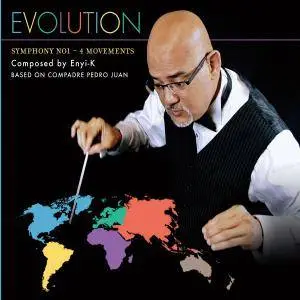Enyi-K - Evolution Symphony No1 (2016)
MP3 CBR 320kbps | Tracks: 4 | 36:48 min | 101 Mb
Style: New Age, Classical | Label: Kennedy Ng
MP3 CBR 320kbps | Tracks: 4 | 36:48 min | 101 Mb
Style: New Age, Classical | Label: Kennedy Ng
Movement 1
It is a beautiful string sound exposing the main theme, where staccatos and dynamic period of classicism are used in joint and harmonious, characteristic shape of that era of music; in addition to the mode, chromatic scales and arpeggios.
Brushstrokes of today’s modern instruments; keyboards, synthesizers sounds simulated embellished partially Caribbean rhythm (merengue pambiche), with typical sounds of saxophones in a unison; syncopated and melodically structured in the genre of traditional merengue, tinged with colors like freeform jazz.
In Mov. 1, the orchestra develops the theme of Symphony Evolution, played by the strings, followed by instruments such as drums, tambora, conga, and saxophones to the rhythm of merengue Pambiche, where the sound of saxophones, with bed electronic background, it transfers control to the classical piano, played with dynamics of classicism period (1750 -1820), in a style similar to that of Wolfgang Amadeus Mozart. Pure music.
Movement 2
The exhibition theme in the second movement, is magnificent and rhythmic, makes an appearance here piano theme 1 in conjunction with Latin percussion, to the rhythm of traditional merengue. The combination of classical music and Latin music, especially the merengue, predominate in this movement. Half of its development can hear a combination of Latin rhythms. We can hear something typical in the popular Latin music, especially in the Salsa of the era of the 70's and 80's: "Moña" Riff musical sentences in unison; electric bass, baritone sax, and piano, with stable Latin percussion rhythm section rate.
However, listening to this movement, you can hear the features of classical music concerto Grosso form, characteristic of the Rococo period (1720); which is the form of musical contrast of phrases and musical passages, played by the full orchestra and sections of the soloists such as brass, reed instruments, especially saxophones, at the end of development of the subject, they will deliver a Jaleo (pure merengue), with an accent "Maco" the beginning of the CODA. The piano picks up the beginning of the coda and gives hints of characteristics of a piano concerto, which in turn delivers the orchestra, the development of the Forte (IV-V7-I) cadence for the end of the movement energy and musical grandiosity.
Movement 3 dialogue between strings, brass and reeds, played with subtle sound of the strings in the form of questions and answers "pure classical music." The staccatos of the orchestra delivered the recapitulation of the main theme of the movement 1 and its development (CPJ theme), with a momentary change of tonality presented in the form of merengue, without percussion, by several measures, followed by exposure of a sub-topic presented by the flutes with piano arpeggios, electronic sounds and percussion sounds elements of the world music who give the opening to the electronic flute melodies running free in structural form, like jazz.
A sequence of intervals of perfect fourth deliver the command to the orchestra, developing the sub-theme in classic form with staccato articulations between the trombones, bass, and strings in rhythmic form of quavers; where the appearance of the accordion gives way to the rhythmic way of feeling Tango, with features of modern music, which delivers an open Bolero / Bachata style using bongo, guiro, and congas. This Caribbean rhythm, gives the piano a subtle passage to classic modern style; seeking the end, with recaps of theme 1, seeking an end with CODA traditional merengue.
Movement 4
This last movement, the 4, the main theme is exposed with the full orchestra in strong shape and feel of suspense, followed by the cadences of traditional rhythm of merengue. The strings are very important, together with the piano,
instruments converse, preserving the beauty of classical music, combined with popular music style.
It is not until the development of the first theme where the Latin percussion; tambora, congas and güira make their entrance.
At the end of development of theme 1, the piano makes a two voices invention passage; J.S.B style, which gives enter of the timbales, Latin percussion interspersed with baroque music. The passages of the orchestra using pentatonic/mode scales, produce a sensation of Middle Eastern music, this feeling is completed with a virtuoso passage of saxophones; arpeggios, scales, syncopated rhythms, highlighting the Caribbean style. CODA is painted with a solo timbales, making way for the conclusion, with the full orchestra, in a vibrant FINALE.
Tracklist:
01. Evolution Symphony No 1, Movement No 1
02. Evolution Symphony No 1, Movement No 2
03. Evolution Symphony No 1, Movement No 3
04. Evolution Symphony No 1, Movement No 4



